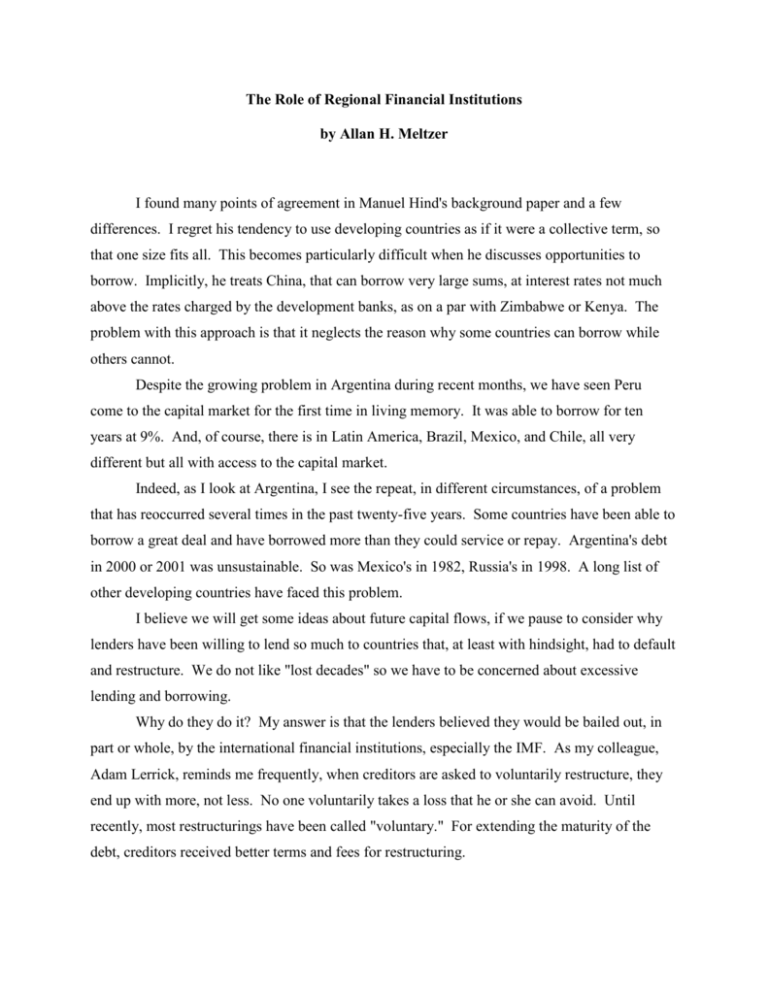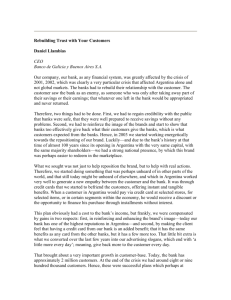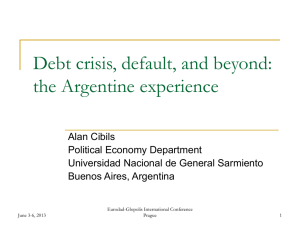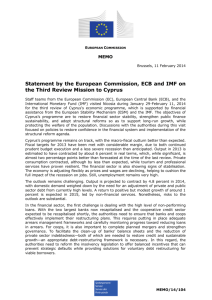The Role of Regional Financial Institutions
advertisement

The Role of Regional Financial Institutions by Allan H. Meltzer I found many points of agreement in Manuel Hind's background paper and a few differences. I regret his tendency to use developing countries as if it were a collective term, so that one size fits all. This becomes particularly difficult when he discusses opportunities to borrow. Implicitly, he treats China, that can borrow very large sums, at interest rates not much above the rates charged by the development banks, as on a par with Zimbabwe or Kenya. The problem with this approach is that it neglects the reason why some countries can borrow while others cannot. Despite the growing problem in Argentina during recent months, we have seen Peru come to the capital market for the first time in living memory. It was able to borrow for ten years at 9%. And, of course, there is in Latin America, Brazil, Mexico, and Chile, all very different but all with access to the capital market. Indeed, as I look at Argentina, I see the repeat, in different circumstances, of a problem that has reoccurred several times in the past twenty-five years. Some countries have been able to borrow a great deal and have borrowed more than they could service or repay. Argentina's debt in 2000 or 2001 was unsustainable. So was Mexico's in 1982, Russia's in 1998. A long list of other developing countries have faced this problem. I believe we will get some ideas about future capital flows, if we pause to consider why lenders have been willing to lend so much to countries that, at least with hindsight, had to default and restructure. We do not like "lost decades" so we have to be concerned about excessive lending and borrowing. Why do they do it? My answer is that the lenders believed they would be bailed out, in part or whole, by the international financial institutions, especially the IMF. As my colleague, Adam Lerrick, reminds me frequently, when creditors are asked to voluntarily restructure, they end up with more, not less. No one voluntarily takes a loss that he or she can avoid. Until recently, most restructurings have been called "voluntary." For extending the maturity of the debt, creditors received better terms and fees for restructuring. In the last few years, something has changed. Starting with Ecuador and most recently in Argentina, countries have defaulted on sovereign debt. In Argentina, new issues offered in July 2001 for $85 sold in November for $25 or $30. Argentine creditors face very large losses. A reasonable guess at this time is that, if the IMF insists that Argentina restructure its debt before it lends any additional money, creditors will receive no more than 25 or 30% of the face value of their bonds. I don't think we can ignore this default and the defaults that preceded it, when thinking about the future of international lending to developing countries. Nor should we ignore the experience itself. One very remarkable fact about Argentina is that responsible observers like Professors Calomiris and Lerrick had, separately, predicted publicly that Argentina would have to default. These predictions became public last winter. Yet, despite these very public warnings, Argentina was able to sell debt at $85 per bond as late as last June. Two significant changes occurred between June and September or October. One we need not pursue today. It became clear as the summer progressed that the de la Rua government and Minister Cavallo had no plan or program for restoring growth or paying the debt. The government made promises about the budget that soon were seen to be empty. An increasingly desperate Minister, thrashing around, is not an attractive sight to creditors. The second big change came in August and after. Instead of the $30 to $40 billion of new loans that some at the IMF wanted to make, Argentina got $5 billion, with $3 billion additional earmarked for debt restructuring. This amount was too small to be useful. Soon after, the new officials at the IMF and the U.S. Treasury made clear that there would be no more money until Argentina met its past commitments. These included a promise to balance the budget monthly. Default now appeared not just likely but inevitable. The days of large bailouts were not over for countries like Turkey, but they were over for many countries. Creditors who had benefited from moral hazard lending now had to be more careful. The risk premiums on some emerging market debt no longer offered a windfall. One implication is that if the IMF keeps to its new policy, creditors will be more careful about the amounts they lend and the countries to which they lend. The entire history of postwar lending to emerging market countries, particularly the last twenty years, occurred under the old rules. The new rules call for greater prudence. 2 What can borrowers do? They can become more prudent also. In the report of the Commission that I chaired, we proposed four conditions for automatic lending by the IMF to countries in difficulty. The four conditions, perhaps supplemented by one or two others, define a prudent macroeconomic policy with diversification of risk. In Brazil and even Argentina, we have seen that one of those conditions -- the presence of competing foreign banks -- greatly increases financial stability. The largest source of capital for developing countries is private lending. Such lending dwarfs any current or prospective lending from all international financial institutions. If the IMF persists in its new policy, borrowers will have to give evidence that current and prospective policies are, and will remain prudent. To be lasting and effective, adoption of prudent policy must be voluntary. The Minister must go to his parliament with a message that says, we must adopt these policies because it is in our interest. We will get more capital, on better terms, to build our country and raise our living standards. We are not making these changes because the IMF insists on it. We make them because they are in our interest. An important role for the MDBs is to help countries that want to attract long-term capital, as foreign direct investment, and to attract foreign banks as participants in this market. They should lend to permit countries to make necessary structural reforms -- instituting the rule of law, reforming the judiciary, establishing transparent accounting and financial practices, adopting financial standards, opening the economy to trade, and securing property rights. Experience in Chile and Mexico gives evidence that with these reforms in place, countries acquire more capital at lower cost. Let me turn to another issue -- the more general role of the IMF and the MDBs and the particular role of the regional banks. The Commission report saw the core competence of the IMF as the prevention and mitigation of crises and collection and dissemination of information on developing countries. If the IMF could free itself of the bureaucratic embellishments that it puts on the proposed Contingent Credit Line (CCL) to make its commitment conditioned only on keeping prudent policies in place, it would take a large step toward more rational financial and institutional structures. Countries would have an incentive to make structural reforms. Those that did would benefit. 3 What should be the role of the development banks? Like Juergen Stark, I believe in specialization. MDBs should not be involved in crisis lending. The Commission proposed three roles: (1) improve the quality of life by making grants instead of loans in very poor countries. Monitor the outcomes, and pay only for performance. To their great credit, Secretary O'Neill and the Bush administration have proposed this policy. President Bush endorsed it in his speech at the World Bank. I believe something along these lines will be done. (2) Lend for structural reforms by making long-term commitments to continue lending for many years provided the country continues to strengthen and extend the reform. This proposal recognizes that reforms take time and, unlike much current structural lending, it does not confuse promise with performance. (3) Lend to support regional and global public goods. There is considerable overlap between the World Bank, the regional banks, and the IMF. I have spoken about the distinct role of the IMF. I believe that if the banks were more effective institutions and had more success, the IMF would, and should, relinquish its role in structural reform and poverty alleviation. How should we separate the tasks of the World Bank and the regional banks? Hinds takes the position that competition between them is useful. This might be true, if they competed and if there was a metric by which we could compare their performances. Where Hinds sees competition, I see overlap and duplication. To move forward, we need to learn about the comparative advantage of the different lenders. The World Bank is generally acknowledged to have greater technical expertise then the others over a wider range of topics. This expertise should be available as a common pool for all development banks to draw upon. To learn more about what MDBs do well, I propose independent performance audits of the major development banks. What do they do well? What do they do poorly? Most of the banks do not evaluate many projects five to ten years after they are completed. An independent performance audit is overdue. One of the striking features of MDB lending is that most of the lending goes to countries that can borrow in the capital markets. This is as true of the IDB as it is of the World Bank. In many of these countries, the MDBs add little or nothing beyond the subsidy. This money should be redirected. The Commission proposed to concentrate the World Bank's lending mainly in Africa and the Middle East. It would supply technical assistance in 4 other regions, but responsibility for lending would remain with the Asian and Inter-American Development banks. I continue to believe that this would reduce costly duplication. In summary, I emphasize the need to shift to more effective policies of grants and lending. Emphasis should shift from how much is lent to what is accomplished. We can wave plastic cards with the numbers living on less than $1 a day until eternity. We will not reduce that number until we have more effective policies. These should start with performance audits and continue with policies that reward incentives. Loans do not raise living standards unless they raise productivity. Incentives at all levels are required to raise productivity. I dislike the word architecture. It suggests a structure that lasts a long time. Development is a process that changes as countries develop. The key word is not architecture - it is incentives. 5







